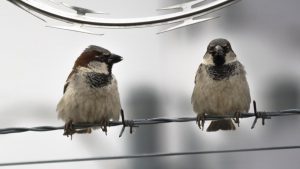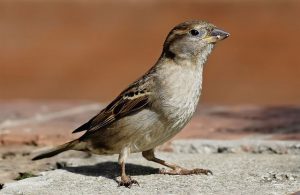The sparrow, with its unmistakable chirping and inexhaustible energy, has been a faithful companion in cities and fields for centuries. Although it is easy to overlook amid urban bustle, this small bird is a symbol of adaptation and resistance in the natural world.
With a plump body and plumage in shades of browns and grays, sparrows stand out for their simple yet charming appearance. Males usually have more marked colors, with details in black, white, and gray on the head and wings. Their short, strong beak is designed for a diet based on seeds, although they also consume insects, making them allies of farmers.
Originally from Europe and Asia, sparrows managed to spread almost worldwide. Their adaptability led them to thrive in urban, suburban, and rural environments. They can be seen fluttering in squares, parks, and gardens, where they find refuge in trees, shrubs, and human structures.
Although their song is not as elaborate as that of other birds, the sparrow compensates with enthusiasm. Their chirping is a series of short and rapid trills, filling the air with a vibrant and constant melody. Their song is not only a form of communication among themselves, but also a familiar sound in our streets and yards.

Nesting and Social Habits
Sparrows are social birds that tend to gather in large flocks. During the breeding season, they build their nests in cracks in buildings, dense shrubs, or any safe space they find. Their nests are made of twigs, grass, and other materials from the environment. Females lay between three and five eggs, which they incubate for about two weeks.
The sparrow arrived in the United States in 1850, when hundreds of them were released in Philadelphia to control caterpillars that were destroying crops. In Argentina, their arrival remains a mystery: some believe they were introduced by Domingo Faustino Sarmiento, while others claim they came on a sailboat from Liverpool. It is said that the Swiss-German brewer Emilio Bieckert brought these birds in cages to remind him of his homeland.
Despite their adaptability, the sparrow population has decreased in some cities due to habitat loss and other environmental factors. However, they remain a beloved presence in many regions of the world.
The sparrow is not just another bird; it is a symbol of nature in everyday life. Their singing and energy remind us of the beauty of the simple and the familiar, even amidst the concrete and noise of the city.

Some Little-Known Curiosities about the Sparrow
In addition to being able to swim, recognize people by their faces and voices, sparrows also:
- Are monogamous, choosing a partner and mating and staying with them for life.
- Feed on seeds, insects, berries, and fruits.
- Can live up to 5 years.
- Have the ability to reach speeds of approximately 45 km/h.
- Take dust baths.
- Make small indentations in the ground to defend their territory.
- Tend to build their nests in cavities or ledges.
- Are birds that in the warm season feed on insects, mainly grasshoppers and locusts.
- In rural areas, they tend to steal feed from farm animals.
- Can eat crushed insects on the fronts of parked cars.
- Have the ability to search for insects in tree bark.
- Are birds that can visit bird feeders to eat a wide variety of foods.
Source: El Diario de Carlos Paz.
Do you already know our YouTube channel? Subscribe now!

